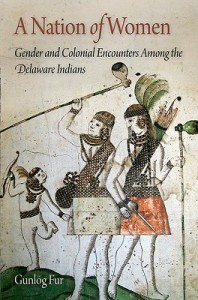 Part I, Part II, Part III, Part IV, Part VIn this week’s discussion of Gunlog Fur’s A Nation of Women: Gender and Colonial Encounters Among the Delaware Indians, we get to the topic of why the Delaware referred to themselves, and were referred to by other Indians, as “a nation of women.”To understand even partially how gender was perceived by seventeenth and eighteenth century Delaware, it is also necessary to appreciate the rigidity of European conceptions of gender roles at that time – in itself a stretch for the twenty-first century mind.The Delaware were known by Iroquois and other Algonquian tribes as “A Nation of Women.” This was not, originally, a derogatory term but an appellation which referred to Delaware willingness and skill in negotiating peace agreements for themselves and between other nations. In the Delaware tradition men were the war captains and women the peace negotiators. Although women did occasionally fight, as givers and nurturers of new life women were considered more suited for the peace giving role. More importantly, the same person could not be permitted to fight and to negotiate peace. It was believed that allowing a warrior to partake in diplomatic efforts would result in either cowardice or perpetual warfare. The power of the war chief must be balanced by the peace chief, and so an individual trained for one path or the other.It is difficult to know the details of women’s involvement in treaty negotiations with Europeans because women are written out of white male accounts, and these historians would not have recognized women’s influence or understood Delaware power dynamics at any rate. British accounts usually list the men involved and do not even mention the presence of women, although in some instances they refer to “sundry women and children” accompanying the Indian men. Other European accounts are more inclusive, but they too focus on men, and Eurocentric gender bias has meant that until recently persons noted by their Indian name were assumed to be male. What is clear is that white men’s preference for dealing with other men on matters of import put Delaware men in a prominent position in these negotiations. (Although Fur doesn’t mention this, I wondered if one of the reasons that Delaware men were negotiating with white men was that European powers sent only men as representatives.) The only way white men could understand women in a position of power was in instances where social class and rank trumped male authority: thus they referred to women who obviously wielded power during negotiations as “queens.” Whether through imprecision in the translation of terms or lack of recognition of the rigidity of European gender boundaries, Delaware men began referring to themselves as queens when engaging in diplomacy.One story that sharply illustrates the dichotomy between Delaware and European attitudes towards gender comes from an oral history recorded in the early twentieth century. In this Delaware account of an outbreak of violence with white settlers, the violence had escalated to an unacceptable level when women on both sides met to explore ways of ending the conflict. They reached an agreement in principle, and so the next day men and women from both sides met to ceremonially formalize the agreement. Details of this oral history are recognizable in a written account of a seventeenth century conflict with Swedish colonials, but there is no mention of any substantive involvement of a woman anywhere. Whether these two accounts do indeed refer to the same incident or not, they illustrate the degree of gender bias in written documents of the time.During diplomacy meetings men sometimes donned ceremonial women’s clothing or carried implements symbolizing women’s roles such as gourds or hoes. They addressed other Delaware men during these formal meetings as “sister” and used words denoting family affiliations such as “sister’s daughter” or “cousin on distaff side” when addressing other Indians. Note that these feminine terms of address referred to matrilineal family relationships, rather than marriage, as metaphors.Inevitably with increased white contact the word “woman” began being used as an epithet toward Delaware men. This was especially true of the Six Nations Iroquois, with their strong British alliance. The British of all the colonials were most critical of anything suggestive of “unmanliness,” a word for which there was no equivalent in Delaware. This culminated in a huge land grab by the British in the mid-eighteenth century which the Iroquois facilitated, justifying the action with the novel legal argument that as women Delaware had no right to own property. (The Iroquois knew such an argument had no validity even among their own people, but they also understood its appeal to their British allies.) Fur devotes some space to speculating why Delaware continued to refer to themselves as “a nation of women” for half a century after the phrase began being used in a derogatory sense, but in my opinion Delaware were just considering the source of the epithet. There was no love lost between Iroquois and Delaware even before European arrivals intensified the conflicts, and Delaware had worse names for the Iroquois than “women.” And despite their high regard for William Penn, by the early 1700s Delaware had voted the English their least favorite white people. It might not have occurred to them to change their perception and presentation of themselves to placate people they held in similarly low regard.Some white men were highly annoyed by belittling terms meaning “women” directed toward Delaware men, especially men who had fought against the Delaware and respected their ferocity on the battlefield. There was a rehabilitation of the Delaware image by some whites in the nineteenth century, and this is where the scary warriors in Last of the Mohicans come in. The argument that “Delaware men could not have been women because they were good fighters” misses the point however. It was precisely because they commanded respect among other nations as warriors that Delaware collectively were allowed to take on the role of “women.”Next week really will be the last week for discussing this book. We will take a further look at what sex and gender meant to the Delaware Indians.
Part I, Part II, Part III, Part IV, Part VIn this week’s discussion of Gunlog Fur’s A Nation of Women: Gender and Colonial Encounters Among the Delaware Indians, we get to the topic of why the Delaware referred to themselves, and were referred to by other Indians, as “a nation of women.”To understand even partially how gender was perceived by seventeenth and eighteenth century Delaware, it is also necessary to appreciate the rigidity of European conceptions of gender roles at that time – in itself a stretch for the twenty-first century mind.The Delaware were known by Iroquois and other Algonquian tribes as “A Nation of Women.” This was not, originally, a derogatory term but an appellation which referred to Delaware willingness and skill in negotiating peace agreements for themselves and between other nations. In the Delaware tradition men were the war captains and women the peace negotiators. Although women did occasionally fight, as givers and nurturers of new life women were considered more suited for the peace giving role. More importantly, the same person could not be permitted to fight and to negotiate peace. It was believed that allowing a warrior to partake in diplomatic efforts would result in either cowardice or perpetual warfare. The power of the war chief must be balanced by the peace chief, and so an individual trained for one path or the other.It is difficult to know the details of women’s involvement in treaty negotiations with Europeans because women are written out of white male accounts, and these historians would not have recognized women’s influence or understood Delaware power dynamics at any rate. British accounts usually list the men involved and do not even mention the presence of women, although in some instances they refer to “sundry women and children” accompanying the Indian men. Other European accounts are more inclusive, but they too focus on men, and Eurocentric gender bias has meant that until recently persons noted by their Indian name were assumed to be male. What is clear is that white men’s preference for dealing with other men on matters of import put Delaware men in a prominent position in these negotiations. (Although Fur doesn’t mention this, I wondered if one of the reasons that Delaware men were negotiating with white men was that European powers sent only men as representatives.) The only way white men could understand women in a position of power was in instances where social class and rank trumped male authority: thus they referred to women who obviously wielded power during negotiations as “queens.” Whether through imprecision in the translation of terms or lack of recognition of the rigidity of European gender boundaries, Delaware men began referring to themselves as queens when engaging in diplomacy.One story that sharply illustrates the dichotomy between Delaware and European attitudes towards gender comes from an oral history recorded in the early twentieth century. In this Delaware account of an outbreak of violence with white settlers, the violence had escalated to an unacceptable level when women on both sides met to explore ways of ending the conflict. They reached an agreement in principle, and so the next day men and women from both sides met to ceremonially formalize the agreement. Details of this oral history are recognizable in a written account of a seventeenth century conflict with Swedish colonials, but there is no mention of any substantive involvement of a woman anywhere. Whether these two accounts do indeed refer to the same incident or not, they illustrate the degree of gender bias in written documents of the time.During diplomacy meetings men sometimes donned ceremonial women’s clothing or carried implements symbolizing women’s roles such as gourds or hoes. They addressed other Delaware men during these formal meetings as “sister” and used words denoting family affiliations such as “sister’s daughter” or “cousin on distaff side” when addressing other Indians. Note that these feminine terms of address referred to matrilineal family relationships, rather than marriage, as metaphors.Inevitably with increased white contact the word “woman” began being used as an epithet toward Delaware men. This was especially true of the Six Nations Iroquois, with their strong British alliance. The British of all the colonials were most critical of anything suggestive of “unmanliness,” a word for which there was no equivalent in Delaware. This culminated in a huge land grab by the British in the mid-eighteenth century which the Iroquois facilitated, justifying the action with the novel legal argument that as women Delaware had no right to own property. (The Iroquois knew such an argument had no validity even among their own people, but they also understood its appeal to their British allies.) Fur devotes some space to speculating why Delaware continued to refer to themselves as “a nation of women” for half a century after the phrase began being used in a derogatory sense, but in my opinion Delaware were just considering the source of the epithet. There was no love lost between Iroquois and Delaware even before European arrivals intensified the conflicts, and Delaware had worse names for the Iroquois than “women.” And despite their high regard for William Penn, by the early 1700s Delaware had voted the English their least favorite white people. It might not have occurred to them to change their perception and presentation of themselves to placate people they held in similarly low regard.Some white men were highly annoyed by belittling terms meaning “women” directed toward Delaware men, especially men who had fought against the Delaware and respected their ferocity on the battlefield. There was a rehabilitation of the Delaware image by some whites in the nineteenth century, and this is where the scary warriors in Last of the Mohicans come in. The argument that “Delaware men could not have been women because they were good fighters” misses the point however. It was precisely because they commanded respect among other nations as warriors that Delaware collectively were allowed to take on the role of “women.”Next week really will be the last week for discussing this book. We will take a further look at what sex and gender meant to the Delaware Indians.
Year: 2013
Owl Calls From Cornell Ornithology
December 26, 2013Happy Solstice
December 21, 2013Zero is the New Queer
December 20, 2013The whole of the universe should be represented by the number zero rather than the number one. When I ran across this contention on the blog of a pagan queer theorist (a queerist?) I decided to ignore this incredible statement, once my head stopped exploding, because it is, er – not credible. But since this idea has actually been seriously entertained by a few other people, I’m going to address it. I will not link to the post, even though the author proudly took credit, because I’m embarrassed for zhir.
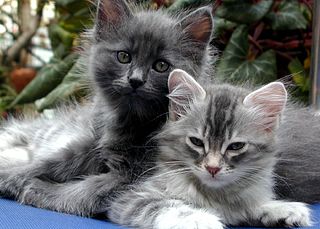


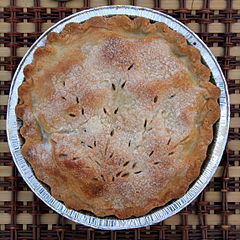
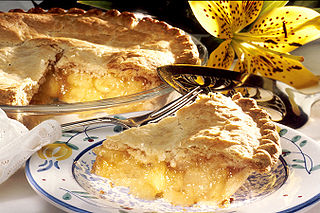 But maybe the source of the confusion comes from the symbol 0, which sortof looks like a pie. It’s the kind of mistake a child would make. You might infer, if you didn’t know any better, that the symbol 0 is defined as the number one, a word which has an O in it. Those of us who are not queerists pay attention in the first grade, at least one-fifth of the time, so we learn our numbers 1, 2, 3, 4, 5, etc., and we use the symbol 0 to designate nothing or as a place-holder. I recommend the first grade to everyone who still calls themselves “queer” and thinks it means something other than “I’m an idiot.” It might mean no longer embarrassing yourself, or zhir-self, or whOever zoo say zoo are.
But maybe the source of the confusion comes from the symbol 0, which sortof looks like a pie. It’s the kind of mistake a child would make. You might infer, if you didn’t know any better, that the symbol 0 is defined as the number one, a word which has an O in it. Those of us who are not queerists pay attention in the first grade, at least one-fifth of the time, so we learn our numbers 1, 2, 3, 4, 5, etc., and we use the symbol 0 to designate nothing or as a place-holder. I recommend the first grade to everyone who still calls themselves “queer” and thinks it means something other than “I’m an idiot.” It might mean no longer embarrassing yourself, or zhir-self, or whOever zoo say zoo are.
A Nation of Women (part V)
December 13, 2013 Another segment of my review/summary of Gunlog Fur’s A Nation of Women: Gender and Colonial Encounters Among the Delaware Indians Here are the links for Part I, Part II, Part III, and Part IV.Marriage is the central organizing principle of patriarchy, and Moravians were attempting to express their ideals of equality within this framework. They saw marriage as having deep spiritual as well as social significance. The married couple and their children were the basic family unit, with the larger church congregation making up the extended family. In contrast, Delaware not only traced their lineage through their mothers, but considered their maternal clan to be their primary family – even in adulthood, even after marriage. When long distance dislocations began occurring due to loss of land, men usually went with their maternal clan rather than remaining with their wives and offspring, leading missionaries to view them as abandoning their families. Delaware men were not indifferent to their wives’ children, but their primary obligation was to the children of their sisters. The large maternal family included both converts and relatives critical of the new religion, which prompted missionaries to stress even more that converts should view marriage and church as their true family. Because Christians offered a dual framework where traditional Indians went to Hell and converted Indians went to Heaven, missionaries were accused of breaking up families in this world and in the afterlife. Missionaries were asking their converts to change their conception of family precisely at a time when loss of land was making traditional family ties more important.Missionaries saw Delaware enthusiasm for travel as threatening to the nuclear family unit, as well as interrupting patterns of worship. Delaware women and men traveled to visit sick relatives, to attend councils and festivals, and to maintain social and family ties. Delaware men would be absent from their village for weeks or even months at a time on hunting expeditions. With women directing food production and male responsibilities in the village conferred mainly through age and experience, it is easy to see how attractive long hunting parties would have been for young men. Close same-sex friendships were a natural part of life for people spending long stretches of time in sex segregated activities, and sometimes these friendships found erotic expression. Fur cannot tell us what degree of significance homosexual activity had for the Delaware, but predictably the missionaries were horrified.For all of these reasons – stability of the nuclear family, reliance on the church congregation, rhythm of Christian worship activities, discouragement of homosexuality, and no doubt their own cultural prejudices – missionaries were eager to make farmers out of Delaware men. The sticky widget was that Delaware women were unwilling to relinquish their authority over agricultural activities. Moravians did not wish to emasculate Delaware men and exhorted women to accept a more subordinate role, usually meeting strong resistence.Both traditional Delawares and missionaries encouraged young people to marry. An eligible young person in a Christian Delaware family could expect frequent introductions to suitable partners arranged by both his or her maternal grandmother and a male missionary, both working independently. Of course the missionary and the grandmother held different views on what constituted a suitable partner. For the maternal grandmother, keeping track of complex family relations to avoid transgressing incest taboos was paramount. A secondary but still important consideration was strengthening family friendships. The missionary was most concerned with matching committed Christians to one another, to avoid losing a convert due to family pressures. The missionary complained in letters and diaries about interference from maternal clan leaders in matchmaking activities he considered his rightful prerogative as Christian leader of the community. We do not have diaries for the grandmothers, but it is easy to infer that they would have had similar words for the male missionary.This discussion about marriage will provide background for the next two posts about gender.
Another segment of my review/summary of Gunlog Fur’s A Nation of Women: Gender and Colonial Encounters Among the Delaware Indians Here are the links for Part I, Part II, Part III, and Part IV.Marriage is the central organizing principle of patriarchy, and Moravians were attempting to express their ideals of equality within this framework. They saw marriage as having deep spiritual as well as social significance. The married couple and their children were the basic family unit, with the larger church congregation making up the extended family. In contrast, Delaware not only traced their lineage through their mothers, but considered their maternal clan to be their primary family – even in adulthood, even after marriage. When long distance dislocations began occurring due to loss of land, men usually went with their maternal clan rather than remaining with their wives and offspring, leading missionaries to view them as abandoning their families. Delaware men were not indifferent to their wives’ children, but their primary obligation was to the children of their sisters. The large maternal family included both converts and relatives critical of the new religion, which prompted missionaries to stress even more that converts should view marriage and church as their true family. Because Christians offered a dual framework where traditional Indians went to Hell and converted Indians went to Heaven, missionaries were accused of breaking up families in this world and in the afterlife. Missionaries were asking their converts to change their conception of family precisely at a time when loss of land was making traditional family ties more important.Missionaries saw Delaware enthusiasm for travel as threatening to the nuclear family unit, as well as interrupting patterns of worship. Delaware women and men traveled to visit sick relatives, to attend councils and festivals, and to maintain social and family ties. Delaware men would be absent from their village for weeks or even months at a time on hunting expeditions. With women directing food production and male responsibilities in the village conferred mainly through age and experience, it is easy to see how attractive long hunting parties would have been for young men. Close same-sex friendships were a natural part of life for people spending long stretches of time in sex segregated activities, and sometimes these friendships found erotic expression. Fur cannot tell us what degree of significance homosexual activity had for the Delaware, but predictably the missionaries were horrified.For all of these reasons – stability of the nuclear family, reliance on the church congregation, rhythm of Christian worship activities, discouragement of homosexuality, and no doubt their own cultural prejudices – missionaries were eager to make farmers out of Delaware men. The sticky widget was that Delaware women were unwilling to relinquish their authority over agricultural activities. Moravians did not wish to emasculate Delaware men and exhorted women to accept a more subordinate role, usually meeting strong resistence.Both traditional Delawares and missionaries encouraged young people to marry. An eligible young person in a Christian Delaware family could expect frequent introductions to suitable partners arranged by both his or her maternal grandmother and a male missionary, both working independently. Of course the missionary and the grandmother held different views on what constituted a suitable partner. For the maternal grandmother, keeping track of complex family relations to avoid transgressing incest taboos was paramount. A secondary but still important consideration was strengthening family friendships. The missionary was most concerned with matching committed Christians to one another, to avoid losing a convert due to family pressures. The missionary complained in letters and diaries about interference from maternal clan leaders in matchmaking activities he considered his rightful prerogative as Christian leader of the community. We do not have diaries for the grandmothers, but it is easy to infer that they would have had similar words for the male missionary.This discussion about marriage will provide background for the next two posts about gender.
Radio Interview with Susun Weed
December 6, 2013 Susun Weed interviewed me about animal magic on her Wise Woman Radio program.
Susun Weed interviewed me about animal magic on her Wise Woman Radio program.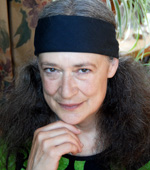 Order Invoking Animal Magic on Amazon here,Or go to book website here.
Order Invoking Animal Magic on Amazon here,Or go to book website here.
 I still have three sections on Gunlog Fur’s A Nation of Women to share. The next will be about marriage (check back on December 13) and the final two about gender.
I still have three sections on Gunlog Fur’s A Nation of Women to share. The next will be about marriage (check back on December 13) and the final two about gender.
Just a reminder…..
December 4, 2013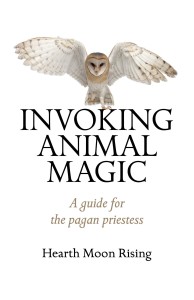 It makes a great gift. Read an excerpt or order through Amazon here.
It makes a great gift. Read an excerpt or order through Amazon here.
A Nation of Women (part IV)
November 29, 2013 I did not it intended for my review/summary of Gunlog Fur’s A Nation of Women: Gender and Colonial Encounters Among the Delaware Indians to be spread over so many weeks, but I also do not like long blog posts. This is the fourth installment, and there will be two more. Here are the links for Part I, Part II, and Part III.There were some aspects of Moravian belief that both hindered and helped their missionary efforts. One of these was the Moravian antipathy for alcohol. Some Delaware chose not to convert because they did not want to stop drinking whiskey, while for others the strictures against alcohol were a factor in conversion. Young mothers, especially, perceived the absence of alcohol in Moravian towns as creating a healthier environment to raise children. While Delaware women were victimized by the male violence that accompanied binge drinking, many Delaware women themselves drank heavily. Women had direct access to alcohol through their trade activities with whites, and at any rate women took responsibility for the distribution of resources. Whiskey obtained from whites was used in ceremonies for mourning the dead, which were women’s ceremonies, but this did not appear to be a source of conflict. It was the more prosaic consumption of alcohol that divided communities.Missionaries attributed drunkeness to Satanic seductions, and Fur does a remarkable job of pointing out the ways missionaries and Delaware converts misapprehended one another on the subject of the Evil One. The Delaware did not have a concept of evil as an animated force, let alone as a personality in opposition to God, with the souls of men and women as battleground between the two powers. They did recognize troublesome and capricious lesser spirits who might wreak havoc or might be beneficial. More often they equated the Devil with vague non-harmonious energies that caused restlessness or worry. Because missionaries characterized Delaware ceremonies and spiritual beliefs as Satanic, many Delaware saw the cosmic play between God and Devil as Indian versus white, and when speaking of a decision to “go to Hell” meant they had chosen to follow the ways that led to the Indian afterlife rather than the Christian one. While missionaries worried that their converts were being subjected to torturous temptations of the Antichrist, Delaware Indians themselves attributed their misbehavior to personal failings or poor choices.Moravian belief stressed a personal and emotional contact with God, and Moravians looked for direct revelations from the Holy Spirit for guidance. When discussion around a problem did not reveal a clear path, they drew lots as a method of divining God’s judgment. In some ways this harmonized with Delaware reliance on dreams and visions for directing personal and community actions. Prophecy through visions could come from any individual, but some were more blessed with this power than others. Prophecy was a talent that garnered respect, and both men and women could be prophets. Visions could provide direct remedies for a problem or delineate ceremonies to address an issue. Often these ceremonies were directed toward healing physical or mental illness. Whites valued and sought Delaware knowledge on herbal healing, but labeled ceremonial healing as wicked and heathen. Other ceremonies were tolerated to some extent. Missionaries tried to substitute Christian songs and prayers for Indian ones in ceremonies for planting, harvest, hunting, burial and marriage. They met resistance even among converts in trying to change rituals around childbirth. Missionaries also had difficulty Christianizing hunting ceremonies to their satisfaction, but the reasons for this are unclear. Fur does not give information about the ceremonies that undoubtedly accompanied menarche and menstruation.The biggest philosophical difference between Delaware and missionary, and one that Moravians may not have entirely understood, was the way conversion itself was viewed, independent of the benefits and failings of the white religion. Moravians viewed conversion as an independent decision, one of personal conscience. Delaware, on the other hand, did not view any important decision as an individual one. Attractions of the new religion had to be weighed against spiritual obligations to the community as a whole, such as role in particular ceremonies or healing talents that could not be expressed in a Christian context. Conversely, when a church member decided to go back to traditional ways, not only the spouse but numerous maternal relatives and members of the extended social network would break away as well.We can’t sum up women’s position in any culture without taking a hard look at marriage. Next week’s post will look at how differing views on marriage and family fueled the most intense conflicts between Moravian missionaries and Delaware Indians, including Delaware converts.
I did not it intended for my review/summary of Gunlog Fur’s A Nation of Women: Gender and Colonial Encounters Among the Delaware Indians to be spread over so many weeks, but I also do not like long blog posts. This is the fourth installment, and there will be two more. Here are the links for Part I, Part II, and Part III.There were some aspects of Moravian belief that both hindered and helped their missionary efforts. One of these was the Moravian antipathy for alcohol. Some Delaware chose not to convert because they did not want to stop drinking whiskey, while for others the strictures against alcohol were a factor in conversion. Young mothers, especially, perceived the absence of alcohol in Moravian towns as creating a healthier environment to raise children. While Delaware women were victimized by the male violence that accompanied binge drinking, many Delaware women themselves drank heavily. Women had direct access to alcohol through their trade activities with whites, and at any rate women took responsibility for the distribution of resources. Whiskey obtained from whites was used in ceremonies for mourning the dead, which were women’s ceremonies, but this did not appear to be a source of conflict. It was the more prosaic consumption of alcohol that divided communities.Missionaries attributed drunkeness to Satanic seductions, and Fur does a remarkable job of pointing out the ways missionaries and Delaware converts misapprehended one another on the subject of the Evil One. The Delaware did not have a concept of evil as an animated force, let alone as a personality in opposition to God, with the souls of men and women as battleground between the two powers. They did recognize troublesome and capricious lesser spirits who might wreak havoc or might be beneficial. More often they equated the Devil with vague non-harmonious energies that caused restlessness or worry. Because missionaries characterized Delaware ceremonies and spiritual beliefs as Satanic, many Delaware saw the cosmic play between God and Devil as Indian versus white, and when speaking of a decision to “go to Hell” meant they had chosen to follow the ways that led to the Indian afterlife rather than the Christian one. While missionaries worried that their converts were being subjected to torturous temptations of the Antichrist, Delaware Indians themselves attributed their misbehavior to personal failings or poor choices.Moravian belief stressed a personal and emotional contact with God, and Moravians looked for direct revelations from the Holy Spirit for guidance. When discussion around a problem did not reveal a clear path, they drew lots as a method of divining God’s judgment. In some ways this harmonized with Delaware reliance on dreams and visions for directing personal and community actions. Prophecy through visions could come from any individual, but some were more blessed with this power than others. Prophecy was a talent that garnered respect, and both men and women could be prophets. Visions could provide direct remedies for a problem or delineate ceremonies to address an issue. Often these ceremonies were directed toward healing physical or mental illness. Whites valued and sought Delaware knowledge on herbal healing, but labeled ceremonial healing as wicked and heathen. Other ceremonies were tolerated to some extent. Missionaries tried to substitute Christian songs and prayers for Indian ones in ceremonies for planting, harvest, hunting, burial and marriage. They met resistance even among converts in trying to change rituals around childbirth. Missionaries also had difficulty Christianizing hunting ceremonies to their satisfaction, but the reasons for this are unclear. Fur does not give information about the ceremonies that undoubtedly accompanied menarche and menstruation.The biggest philosophical difference between Delaware and missionary, and one that Moravians may not have entirely understood, was the way conversion itself was viewed, independent of the benefits and failings of the white religion. Moravians viewed conversion as an independent decision, one of personal conscience. Delaware, on the other hand, did not view any important decision as an individual one. Attractions of the new religion had to be weighed against spiritual obligations to the community as a whole, such as role in particular ceremonies or healing talents that could not be expressed in a Christian context. Conversely, when a church member decided to go back to traditional ways, not only the spouse but numerous maternal relatives and members of the extended social network would break away as well.We can’t sum up women’s position in any culture without taking a hard look at marriage. Next week’s post will look at how differing views on marriage and family fueled the most intense conflicts between Moravian missionaries and Delaware Indians, including Delaware converts.
A Nation of Women (part III)
November 22, 2013 This is a continuation of my summary/review of Gunlog Fur’s A Nation of Women: Gender and Colonial Encounters Among the Delaware Indians. Here is part II and part I. This third installment discusses Delaware spiritual beliefs as revealed in encounters with Christian missionaries.The Delaware responded to the first hellfire preachers with alarm, thinking they had come to declare war. When that misunderstanding was put away, many Delaware continued to attend sermons, curious about Christian beliefs or perhaps entertained by what preachers had to say. Still, Christian missionaries had few converts. This changed with efforts of Moravian missionaries to Christianize the Delaware in the mid eighteenth century.Fur notes research suggesting that efforts to convert North American Indians in the seventeenth and eighteenth centuries resulted in one of three predictable outcomes: the entire tribe decided to convert, the tribe decided not to convert, or there was conflict along gender lines around the issue of converting. There were serious conflicts among Delawares about the presence of missionaries and decisions to convert, but interestingly these conflicts were not split along gender lines. Fur notes that Delaware women both participated in and fought white missionary efforts during this period. To make sense of the conflicts and alliances that arose, it is necessary to understand not only Delaware cultural beliefs but some of the beliefs around culture and gender held by the Moravians.The Moravians were remarkably egalitarian for the times, even compared to other progressive sects, with ideals reminiscent of the very early Christians. They not only preached that men and women were equal in the eyes of God, but allowed women to speak in mixed gender congregations and to hold leadership positions. They had feminine conceptions of the Holy Spirit and utilized metaphors for Christ that were less heavily gendered than other sects. Moravians preferred to work in sex segregated groups and the majority of their religious activities were sex segregated as well. Missionaries had to be married, as men proselytized to other men and women to other women. Unlike the early Christians, Moravians did not hold sexual relations to be shameful, at least in the context of heterosexual marriage, and they placed no value on celibacy. They strove to introduce Christianity in an ethnically sensitive way, at least as they understood the concept, and missionaries not only learned the Delaware languages but taught in those languages and translated written religious materials into Delaware. Missionaries were expected to live and work in the manner of people they were trying to convert, insofar as it did not conflict with their Christian values, so Moravian missionaries labored alongside their converts. It seems that if any group could make Christianity acceptable to the Delaware, it was the Moravians.The environmental stressors afflicting the Delaware at the time of initial contact with the Moravians were another factor in Delaware receptivity to their message. Delaware peoples had been in contact with Europeans for two centuries when Moravian missionary efforts began in the mid-eighteenth century, and during that time life had changed dramatically. Contagious diseases such as smallpox appeared in waves infecting each generation, reducing the population by between 75 and 90%. Delaware lived peaceably with some white settlements, but had experienced violence and betrayal from others. Alcohol had devastating effects on families. Long-standing conflicts with Iroquois nations to the north and west became increasingly violent as Iroquois sought to appropriate Delaware territory to improve their access to the European fur trade. Delaware had survived all of these challenges with traditional culture intact, but the first part of the eighteenth century saw a much greater white encroachment on Delaware land, blocking access to traditional food sources and forcing widespread relocation of villages. Delaware were beginning to experience significant food shortages, a new experience for people living in a moderate climate with fertile land and abundant wildlife. Hunger and loss of land, combined with long-standing problems of disease and warfare, made many open to religious solutions offered by the new missionaries.Moravian missionaries had serious conflicts with other whites, for both political and theological reasons, which may have been a point in their favor from the perspective of many Delaware. One conflict revolved around the staunch and inflexible pacifism Moravians adhered to. Within Delaware communities, the principle of pacifism shored up one faction in the ongoing debate over how to respond to white encroachment. While Delaware peoples did not approve of warfare as a way of life, they did go to war to defend their territories, and debate ensued throughout the eighteenth century over which was the better strategy, mediation or war. This debate appears to have hinged on practical considerations, but Moravian missionaries with their message of pacifism appeared on the scene at a time when Delaware leaders were trying to rein in their warriors and arrive at a political solution with European and Indian nations. Since mediation was the purview of women, just as conducting warfare that of men, we can assume that women were actively involved in this decision.Many women who sought or accepted interaction with Moravians were motivated by concern for their children, as the Indian villages of the Moravians were considered safer and more secure in their food supplies. Women also wanted their children to learn to read and write. Child mortality was a factor, with women often seeking baptism for dying children. Fur does not speculate on the reasons for this, even while noting that baptism for adults approaching death was much less common.Christianity was a highly polarizing issue for eighteenth century Delaware. For all the attractions the Moravian brand of Christianity held for some Delaware women (and men), there was also strong opposition toward missionizing of any stripe. The next installment looks at reasons many women found Moravian beliefs incompatible with their way of life. This section will have a bit more on Delaware spiritual beliefs. I post on Fridays, so look for this on November 29th.
This is a continuation of my summary/review of Gunlog Fur’s A Nation of Women: Gender and Colonial Encounters Among the Delaware Indians. Here is part II and part I. This third installment discusses Delaware spiritual beliefs as revealed in encounters with Christian missionaries.The Delaware responded to the first hellfire preachers with alarm, thinking they had come to declare war. When that misunderstanding was put away, many Delaware continued to attend sermons, curious about Christian beliefs or perhaps entertained by what preachers had to say. Still, Christian missionaries had few converts. This changed with efforts of Moravian missionaries to Christianize the Delaware in the mid eighteenth century.Fur notes research suggesting that efforts to convert North American Indians in the seventeenth and eighteenth centuries resulted in one of three predictable outcomes: the entire tribe decided to convert, the tribe decided not to convert, or there was conflict along gender lines around the issue of converting. There were serious conflicts among Delawares about the presence of missionaries and decisions to convert, but interestingly these conflicts were not split along gender lines. Fur notes that Delaware women both participated in and fought white missionary efforts during this period. To make sense of the conflicts and alliances that arose, it is necessary to understand not only Delaware cultural beliefs but some of the beliefs around culture and gender held by the Moravians.The Moravians were remarkably egalitarian for the times, even compared to other progressive sects, with ideals reminiscent of the very early Christians. They not only preached that men and women were equal in the eyes of God, but allowed women to speak in mixed gender congregations and to hold leadership positions. They had feminine conceptions of the Holy Spirit and utilized metaphors for Christ that were less heavily gendered than other sects. Moravians preferred to work in sex segregated groups and the majority of their religious activities were sex segregated as well. Missionaries had to be married, as men proselytized to other men and women to other women. Unlike the early Christians, Moravians did not hold sexual relations to be shameful, at least in the context of heterosexual marriage, and they placed no value on celibacy. They strove to introduce Christianity in an ethnically sensitive way, at least as they understood the concept, and missionaries not only learned the Delaware languages but taught in those languages and translated written religious materials into Delaware. Missionaries were expected to live and work in the manner of people they were trying to convert, insofar as it did not conflict with their Christian values, so Moravian missionaries labored alongside their converts. It seems that if any group could make Christianity acceptable to the Delaware, it was the Moravians.The environmental stressors afflicting the Delaware at the time of initial contact with the Moravians were another factor in Delaware receptivity to their message. Delaware peoples had been in contact with Europeans for two centuries when Moravian missionary efforts began in the mid-eighteenth century, and during that time life had changed dramatically. Contagious diseases such as smallpox appeared in waves infecting each generation, reducing the population by between 75 and 90%. Delaware lived peaceably with some white settlements, but had experienced violence and betrayal from others. Alcohol had devastating effects on families. Long-standing conflicts with Iroquois nations to the north and west became increasingly violent as Iroquois sought to appropriate Delaware territory to improve their access to the European fur trade. Delaware had survived all of these challenges with traditional culture intact, but the first part of the eighteenth century saw a much greater white encroachment on Delaware land, blocking access to traditional food sources and forcing widespread relocation of villages. Delaware were beginning to experience significant food shortages, a new experience for people living in a moderate climate with fertile land and abundant wildlife. Hunger and loss of land, combined with long-standing problems of disease and warfare, made many open to religious solutions offered by the new missionaries.Moravian missionaries had serious conflicts with other whites, for both political and theological reasons, which may have been a point in their favor from the perspective of many Delaware. One conflict revolved around the staunch and inflexible pacifism Moravians adhered to. Within Delaware communities, the principle of pacifism shored up one faction in the ongoing debate over how to respond to white encroachment. While Delaware peoples did not approve of warfare as a way of life, they did go to war to defend their territories, and debate ensued throughout the eighteenth century over which was the better strategy, mediation or war. This debate appears to have hinged on practical considerations, but Moravian missionaries with their message of pacifism appeared on the scene at a time when Delaware leaders were trying to rein in their warriors and arrive at a political solution with European and Indian nations. Since mediation was the purview of women, just as conducting warfare that of men, we can assume that women were actively involved in this decision.Many women who sought or accepted interaction with Moravians were motivated by concern for their children, as the Indian villages of the Moravians were considered safer and more secure in their food supplies. Women also wanted their children to learn to read and write. Child mortality was a factor, with women often seeking baptism for dying children. Fur does not speculate on the reasons for this, even while noting that baptism for adults approaching death was much less common.Christianity was a highly polarizing issue for eighteenth century Delaware. For all the attractions the Moravian brand of Christianity held for some Delaware women (and men), there was also strong opposition toward missionizing of any stripe. The next installment looks at reasons many women found Moravian beliefs incompatible with their way of life. This section will have a bit more on Delaware spiritual beliefs. I post on Fridays, so look for this on November 29th.
A Nation of Women (part II)
November 15, 2013 This is a continuation of my summary of Gunlog Fur’s book A Nation of Women: Gender and Colonial Encounters Among the Delaware Indians. This week’s focus is the position of women in Delaware cultures.A note on terminology. The peoples of what is now southeastern New York, eastern Pennsylvania, New Jersey, and northern Delaware were diverse loosely organized tribes who usually (but not always) spoke similar Algonquian languages. Some of the tribes with larger populations included the Unami-speaking Lenape, the Munsee, and the Mahican, but there were many others. Trade and treaty relations with Europeans, as well as dislocation patterns, created the polity known today as the Delaware. The word “Delaware” comes from the name the English gave to that river. Fur does not like to use the word “Delaware” for people of this region in their initial contact with Europeans for a variety of reasons, the most obvious one being that the word did not yet exist. Although Fur appears to have thought carefully about which name she uses in each context, I am not going to switch back and forth between “Delaware,” “Lenape,” and “Munsee” in these short blog posts because it would become too confusing for the reader. If you want a more nuanced version, you will have to read the book. The hard fact of the matter is that while some words are better than others in discussing colonial-era history in this region, no word is completely correct.At time of European contact, Delaware cultures were matrilineal. Children belonged to the mother’s family. Men moved in with the wife’s family after marriage but maintained obligations to their maternal clan. Divorce was not uncommon and could be initiated by either party.Women cared for small children, gathered wild vegetable foods, cleaned game, prepared food, and did most of the agricultural work. They made storage containers for food and implements for cooking and planting. They made clothing and spun hemp for rope and nets. Women kept track of astronomical data that guided planting and other activities. They gathered herbs and practiced herbal medicine. Children worked with their mothers and her female relatives.Men hunted and fished, cleared land for planting, built lodges, and trained for warfare. They wove fishing nets and fashioned and maintained tools involved in hunting and war. Old men and children guarded planted fields from predators.These activities were not strictly divided by sex, however, and women commonly engaged in hunting and occasionally in war. Men would also perform activities assigned to women, such as sewing or spinning. During key activities, such as harvest, large scale hunts or seasonal food gathering, everyone participated. Fur points out that it makes more sense to think of spheres of responsibility rather than division of labor when discussing work done by men versus women. There was cross-over in almost every area. Women and men dressed essentially the same, except during certain labor or ceremonial activities. Men often wore a distinct hair style.Women and men spent a significant amount of time in sex segregated or mostly sex segregated groups. Able bodied men would spend weeks away from the village on hunting expeditions, and women had their own sex segregated activities. Women retreated from village activity during their menstrual periods to a place set aside for this.Land belonged collectively to all Delaware, but management and decision-making around land use–both agricultural land and land used in hunting–rested with the women. The lodge-style houses, which sheltered many generations, belonged to the women. Decisions on food distribution, including game procured by men, were made by women. Since the Delaware were subsistence level farmers and hunter/gatherers, the distribution of food was a significant sphere of influence. When trade began with the Europeans, it was primarily trade of agricultural and household goods, conducted by women, which gave women further control over the distribution of resources. Women effectively determined whether prisoners of war lived or died, since decisions regarding adoption, including adoption of adults, rested with women in their capacity as mothers. Peace making was directed primarily by women, although that changed with European contact.Whether explorers, traders, missionaries or warriors, European men found Delaware power structures difficult to fathom. This might indicate that Delaware cultures were nonhierarchical, that many decisions involved the larger group and not just the designated individual or council, or that decisions were significantly influenced by women. Fur offers data supporting all these suppositions. Indications of rank were remarkably absent in Delaware cultures, even when compared to other northeastern Algonquian tribes. There were no differentiations in burial, for example, and there were no status markers of personal adornment. This does not necessarily mean that Delaware cultures were completely nonhierarchical; only that there were no outward signs of social hierarchy that could be discerned by Eurocentric perception.The chiefs were usually, but not always, male. There were lots of chiefs. There was a war chief and a peace chief, a chief for the maternal clan, a chief who welcomed strangers to the village, etc. etc. Some of these offices delineated duties for the husband and the wife, so they might also be conceived as being held by a couple. The chief chose and trained his successor, who was almost always from his maternal clan. Sons did not succeed fathers. The chiefs answered to the village council, which was composed of men and women. The council was expected to refer to the community as a whole on important decisions. Ability to influence others in the community tended to rest on experience, wisdom, age, and position as maternal clan leader.In making important decisions the Delaware placed significant weight on dreams and visions as related by the individuals who experienced them. This will be discussed in the next part of this summary, on early Delaware interactions with Christianity.
This is a continuation of my summary of Gunlog Fur’s book A Nation of Women: Gender and Colonial Encounters Among the Delaware Indians. This week’s focus is the position of women in Delaware cultures.A note on terminology. The peoples of what is now southeastern New York, eastern Pennsylvania, New Jersey, and northern Delaware were diverse loosely organized tribes who usually (but not always) spoke similar Algonquian languages. Some of the tribes with larger populations included the Unami-speaking Lenape, the Munsee, and the Mahican, but there were many others. Trade and treaty relations with Europeans, as well as dislocation patterns, created the polity known today as the Delaware. The word “Delaware” comes from the name the English gave to that river. Fur does not like to use the word “Delaware” for people of this region in their initial contact with Europeans for a variety of reasons, the most obvious one being that the word did not yet exist. Although Fur appears to have thought carefully about which name she uses in each context, I am not going to switch back and forth between “Delaware,” “Lenape,” and “Munsee” in these short blog posts because it would become too confusing for the reader. If you want a more nuanced version, you will have to read the book. The hard fact of the matter is that while some words are better than others in discussing colonial-era history in this region, no word is completely correct.At time of European contact, Delaware cultures were matrilineal. Children belonged to the mother’s family. Men moved in with the wife’s family after marriage but maintained obligations to their maternal clan. Divorce was not uncommon and could be initiated by either party.Women cared for small children, gathered wild vegetable foods, cleaned game, prepared food, and did most of the agricultural work. They made storage containers for food and implements for cooking and planting. They made clothing and spun hemp for rope and nets. Women kept track of astronomical data that guided planting and other activities. They gathered herbs and practiced herbal medicine. Children worked with their mothers and her female relatives.Men hunted and fished, cleared land for planting, built lodges, and trained for warfare. They wove fishing nets and fashioned and maintained tools involved in hunting and war. Old men and children guarded planted fields from predators.These activities were not strictly divided by sex, however, and women commonly engaged in hunting and occasionally in war. Men would also perform activities assigned to women, such as sewing or spinning. During key activities, such as harvest, large scale hunts or seasonal food gathering, everyone participated. Fur points out that it makes more sense to think of spheres of responsibility rather than division of labor when discussing work done by men versus women. There was cross-over in almost every area. Women and men dressed essentially the same, except during certain labor or ceremonial activities. Men often wore a distinct hair style.Women and men spent a significant amount of time in sex segregated or mostly sex segregated groups. Able bodied men would spend weeks away from the village on hunting expeditions, and women had their own sex segregated activities. Women retreated from village activity during their menstrual periods to a place set aside for this.Land belonged collectively to all Delaware, but management and decision-making around land use–both agricultural land and land used in hunting–rested with the women. The lodge-style houses, which sheltered many generations, belonged to the women. Decisions on food distribution, including game procured by men, were made by women. Since the Delaware were subsistence level farmers and hunter/gatherers, the distribution of food was a significant sphere of influence. When trade began with the Europeans, it was primarily trade of agricultural and household goods, conducted by women, which gave women further control over the distribution of resources. Women effectively determined whether prisoners of war lived or died, since decisions regarding adoption, including adoption of adults, rested with women in their capacity as mothers. Peace making was directed primarily by women, although that changed with European contact.Whether explorers, traders, missionaries or warriors, European men found Delaware power structures difficult to fathom. This might indicate that Delaware cultures were nonhierarchical, that many decisions involved the larger group and not just the designated individual or council, or that decisions were significantly influenced by women. Fur offers data supporting all these suppositions. Indications of rank were remarkably absent in Delaware cultures, even when compared to other northeastern Algonquian tribes. There were no differentiations in burial, for example, and there were no status markers of personal adornment. This does not necessarily mean that Delaware cultures were completely nonhierarchical; only that there were no outward signs of social hierarchy that could be discerned by Eurocentric perception.The chiefs were usually, but not always, male. There were lots of chiefs. There was a war chief and a peace chief, a chief for the maternal clan, a chief who welcomed strangers to the village, etc. etc. Some of these offices delineated duties for the husband and the wife, so they might also be conceived as being held by a couple. The chief chose and trained his successor, who was almost always from his maternal clan. Sons did not succeed fathers. The chiefs answered to the village council, which was composed of men and women. The council was expected to refer to the community as a whole on important decisions. Ability to influence others in the community tended to rest on experience, wisdom, age, and position as maternal clan leader.In making important decisions the Delaware placed significant weight on dreams and visions as related by the individuals who experienced them. This will be discussed in the next part of this summary, on early Delaware interactions with Christianity.



